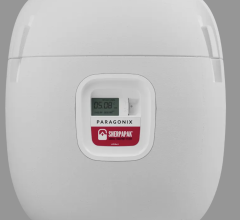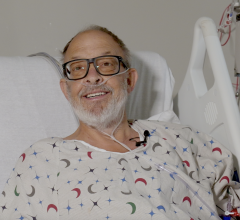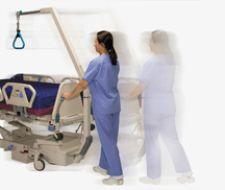
Sinai Hospital in Baltimore uses Hill-Rom's Intellidrive Transport System, which allows a single staff member to easily and safely push, guide and brake a
With the rising obesity problem in the U.S., transporting larger patients around hospitals has become more difficult and presents liability issues for the healthcare facilities, and a safety issue for staff.
Bariatric patients require attention that goes beyond basic clinical care and need special beds, wheelchairs, transfer aids and equipment that can accommodate the extra weight and girth. Prith Peiris, M.D., Mayo Clinic College of Medicine, Rochester, MN, discussed bariatric transport issues and offered advice during a panel discussion at the 2007 American Society of Anesthesiologists Annual Meeting in San Francisco.
Dr. Peiris says there are inherent dangers to both the clinician and the patient involved with transporting bariatric patients. He says hospitals must get the right equipment to limit their liability. It is important staff members make sure they do not exceed the weight limits posted on the equipment and it should not be assumed the manufacturer has built in leeway. He cautions it would be the hospital's liability if a weight limit is exceeded and the equipment breaks, causing injury to a patient.
Nurses lose a combined average of 750,000 workdays each year as a result of back injury, according to the U.S. Bureau of Labor Statistics. For this reason, Dr. Peiris says staff members should know their weight-lifting limits, how to properly lift using their legs, and make sure they are not twisting their body as they lift. He says clinicians should eliminate lifting patients whenever possible using simple techniques, such as having the patients move themselves.
Bariatric patients are very aware of their weight and for most their No. 1 concern is falling and not being able to get up, Dr. Peiris says. Clinicians need to keep that fear in mind whenever they move a bariatric patient. To put patient fears at ease, he suggests informing them about the plan to move them, let the patient help with the movement as much as possible, and not to make any sudden movements during the move.
Once a patient is on a bed or gurney, Dr. Peiris recommends using safety restraints to prevent the patients from falling during transport and injuring themselves or clinicians. Proper positioning of morbidly obese patients is also very important. He said large patients can have difficulty breathing when lying down, so he suggests raising the upper portion of the patient's body using regular pillows or specially designed bariatric ramp-shaped pillows.
There are a variety of devices to help clinicians move obese patients. Dr. Peiris suggests using ceiling hoists and gantry systems to lift heavy patients onto wheelchairs, gurneys or OR tables. Passive floor lifts, which resemble car engine hoists, can be wheeled near a bed and a harness attached to a patient to lift them and then manually wheel them into position so they can be lowered onto transport equipment.
Dr. Peiris highlighted the Air Pal made by Patient Transfer Systems, which pumps air into a big air mattress to create a platform for the patient. Air is also forced out the base of the mattress so it hovers, making the patient very easy to move. However, he warns that several staff members may be needed around the patient to help stabilize the patient so they don't roll off while being moved. The Air Pal pads come in several different sizes, including one for obese and one for super-obese patients.
Smart Medical Technology Inc. offers a similar inflatable mat, the Liftaem. The company says it enables clinicians to transfer a patient from a bed to a stretcher or other surface on a single-patient-use inflatable mat, even when the patient weighs up to 1,000 pounds. The single-use mats help prevents patient cross-contamination. The mats are placed on the patients' beds when they are admitted and remain with them for the duration of their stay. Carts used for inflation are placed throughout the hospital in areas with high numbers of patient transfers.
Practical considerations
“In the last three to five years there has been a boom in specialized bariatric equipment,” said Jennifer Fimiani, RN, BSN, CWOCN, enterostomal therapy nurse at Sinai Hospital of Baltimore. “The weight limits and the width of the beds has increased.”
She says most of Sinai's beds have gone from a weight limit of 300 pounds to 500 pounds to accommodate the growing obesity of patients.
Fimiani says the girth of bariatric equipment and devices is very important, especially with beds and wheelchairs. She said Sinai has seen many patients who are less than 500 pounds who have a larger girth than what some of the bariatric beds were designed for.
In the bariatric transport product market, Fimiani says KCI and Hill-Rom are among the big players, although there are dozens of companies that make very similar devices. She said all of the products work and pretty much do the same thing; however, some are easier to use, or combine features for more efficiency.
“It really comes down to packaging (the features) and what is user friendly and cost effective,” she says.
When purchasing bariatric beds, Fimiani said they need to be strong and wide. However, if they are too wide the bed will not fit through doorways, so the best models are those that can shrink to fit through doors and into elevators.
For example, KCI offers the 1,000-pound capacity BariMaxx bed with a power drive bed system that is also expandable from 36 to 48 inches wide. Fimiani says most bariatric beds have side rails that can be removed to reduce the width by at least a couple inches.
A helpful item bariatric beds should be equipped with is a transport assist device, Fimiani says. Sinai Hospital uses Hill-Rom's Intellidrive Transport System with a steering and braking system so one staff member can easily wheel a patient bed from one location to another. She says this system means less staff is needed to transport a patient, and the risk of injury is lower because the bed will not gain momentum and get away from the staff member.
Hospitals should also assess whether their current walkers, commodes and wheelchairs are adequate for bariatric patients.
When considering bariatric equipment for patients, Fimiani says hospitals should also consider buying room chairs and waiting room furniture that can accommodate larger visitors.
“Bariatric patients usually have bariatric families,” Fimiani explained. <

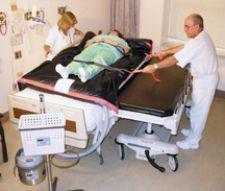
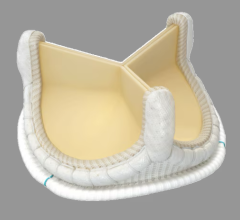
 April 23, 2024
April 23, 2024 




